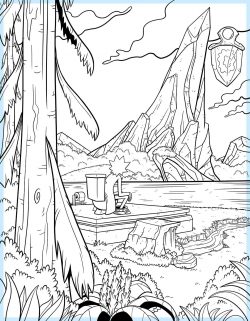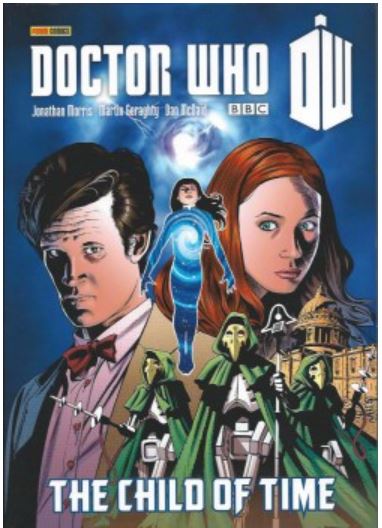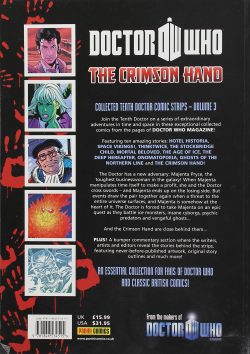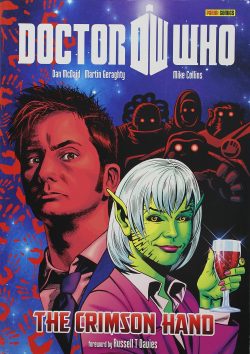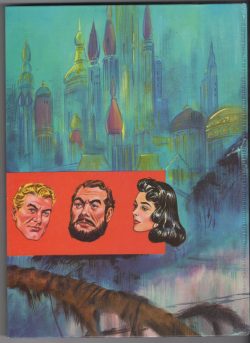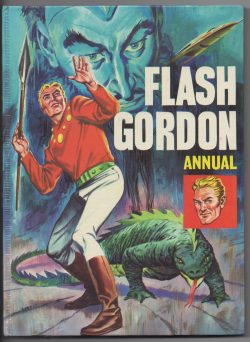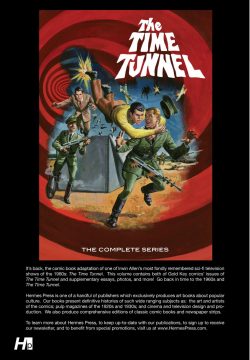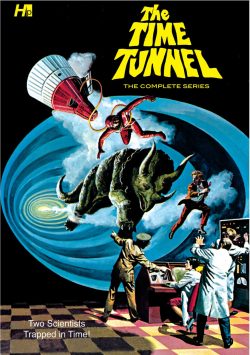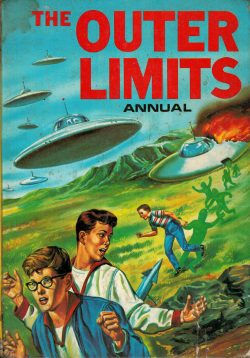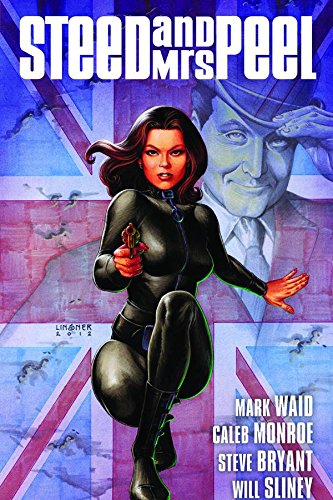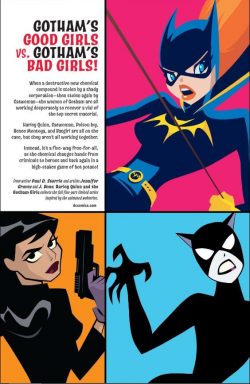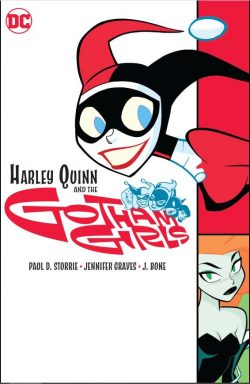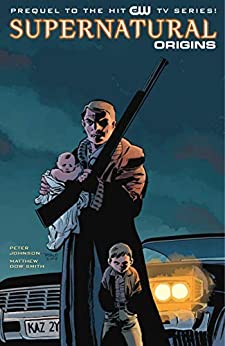

Supernatural: Origins
By Peter Johnson, Geoff Johns, Matthew Don Smith & various (DC/WildStorm)
ISBN: 978-1-4012-1701-3 (TPB/Digital edition) 978-1-84576-754-7 (TPB Titan Books edition)
Supernatural: The Dogs of Edinburgh
By Brian Wood, Grant Bond, Matthew Don Smith & various (DC Entertainment)
ISBN: 978-1-4012-3506-2 (TPB/Digital edition)
Comics have always enjoyed a long, successful affiliation and nigh-symbiotic relationship with television, but in these days when even the ubiquitous goggle-box business is paralysed and endangered by on-demand streaming, too many channels and far too much choice, the numbers and types of program that migrate to funnybooks is increasingly limited.
Excluding kids’ animation shows, cult fantasy adventure series now predominate in this dwindling arena and one of the best to make that transition to the printed page was the epic monster-fighting saga of two brothers literally on the road to Hell as they tracked down unnatural horrors, mystical malignancies and all the unexplainable things that treat humanity as fair game and delicious delicacies…
Over 15 seasons of 327 episodes and spanning from September 13th 2005 to November 19th, 2020, TV series Supernatural followed Sam and Dean Winchester whose lives were forever changed when a yellow-eyed demon killed their mother. The horrific event drove distraught John Winchester into a life of eternal wandering: stalking and killing impossible beasts and horrors he now knew lurked in every shadow.
Years later, rumours still abound that the show will return… soon!
After growing up from a baby on the road to hell, Sam got out of the life and tried to live a normal existence before being dragged back when his surly, alienated brother called to say that their dad had gone missing. It happened right about the time Sam’s girlfriend was killed by a fiery demon…
If you’re looking for a spooky, rowdy, funny binge watch, go no further. Moreover, as we do comics here and the series was rapidly picked up for a spinoff funnybook series, you could also enjoy some printed scary stories…
Supernatural: Origins is an impressive official prequel to the epic show, following the dysfunctional Winchester family in the days, months and years after the boys’ mother floated up into the air and spontaneously combusted. It left their father with unanswerable questions, a hunger for vengeance and two rather unnatural kids to raise…
After Mary’s death, John packs toddler Dean and baby Sam into his car and goes into a spin of booze and bar-fights, until he meets palm-reader Missouri Mosley. The prognosticator offers veiled answers and a glimpse into a world of mumbo-jumbo which is proven to be savagely real when an unseen thing kills Mary’s best friend Julie. She was babysitting the traumatised boys at the time of her demise, and lodged in her ghastly remains was a huge, rune-carved fang from no creature ever born on Earth…
Armed only with hints into the true nature of the world, the former marine begins a quest for the tooth’s owner and in Tempe, Arizona meets prickly, reclusive scholar Fletcher Gable. He identifies it as belonging to a Black Shuck… a Hellhound…
Sending the senior Winchester on to a reported sighting of such in California, the savant offers a further gift: a blank journal to record the notes, photos, clippings, drawings, thoughts and experiences that will inevitably occur and need reporting now that father and sons are irrevocably set on their particular road to Perdition…
The wise man and his latest student are both painfully unaware that Winchester is himself being hunted…
When Mary’s formidable brother Jacob comes looking for the boys and fearing the worst (although he has no idea of what the can worst actually be), he too is embroiled in the quest – to his eternal regret – and only the arrival of the mysterious shadower saves John from becoming the latest casualty of the hellhound…
‘Hunter’ – more job description than name – helps Winchester clear up the mess and cover up the evidence before introducing the now-doubly bereaved and shell-shocked single parent to the full horror of the hidden world of the Supernatural. It’s 1983 and all Hell’s breaking loose…
Winchester becomes part of an amorphous hidden association of loners known as Hunters: mortals who’ve lost loved ones, seen the truth and had the guts to look for payback. Partnered with his brusque and enigmatic mentor, John Winchester is still looking for a golden eyed demon and a hellhound with a missing fang as he tackles his first monster – a leaping carnivore known as a “Heeler” with Hunter and another clean-up man named Ichi.
Sadly, by the time the trio return to the grimly unique bar called Harvell’s Roadhouse – where Sam & Dean have been waiting under the lethally efficient care of waitress Ellen – John is a full-blooded monster killer. Good thing too, as Ichi isn’t friendly or human anymore…
Thus begins a perilous pattern: John and Hunter dumping the kids on someone oblivious or horribly in on the secret for a few days as they take care of business. That journal rapidly fills up with accounts of incredible horror…
Winchester learns fast and, after meeting a resurrected priest who grants him a few precious, tainted moments with Mary’s spirit, he and his extremely hands-on senior partner revisit Fletcher Gable with useful intel on the rune-carved fang. Before long they’re headed to one of the spookiest locations in America and an appalling gauntlet of terrors, a confrontation with the hellhound and its master, inevitable betrayal and an explanation for all that the bereaved father and his sons have endured…
Dotted with moving, telling “flashbacks” – like the moment in 1991 when independent, lethally dangerous Dean has enough and tries to run away, abandoning dad and little brother to an interminable legion of monsters – this initial chronicle also includes a short tale of the boys by Geoff Johns, Phil Hester & colourist JD Mettler.
‘Speak No Evil’ harks back to a day in 1989 when taciturn Sam asked his big brother just how their mother died. He might even have received an answer if a demon hadn’t smashed through the motel window just then, locked in a death grip with their father…
This rip-snorting, tense and moody thriller lives up to the demands of the dedicated TV following and still fulfils all that’s demanded of a horror comic for readers who haven’t tracked the torturous trail of the Winchesters, and this chilling compendium even offers in-process views of covers by Tim Sale, plus pin-ups, working drawings and sketches by series illustrator Matthew Dow Smith.
Supernatural: The Dogs of Edinburgh compiles volume 4 #1-6 from 2011, and was written by Brian Wood (DMZ, X-Men, Northlanders, Moon Knight), with art from Grant Bond (Revere, The Clockwork Girl) & Matthew Don Smith. It examines a different piece of the past and sees Sam returning to Scotland after years away.
Back then, he was no killer of killers but a student on a research grant from Stamford University. His journey of discovery to Edinburgh University was initially educational, but immensely brightened by meeting mysterious lass Emma – “of the Isles” – who seemed interested in exactly the same arcane nonsense he was. She was also really pretty…
It turned out that Emma was a Breaker – the Scottish equivalent of Hunters – and as they grew closer she showed him the mystic highlights of the ancient city. He found himself falling, but was also increasingly aware that Emma wasn’t like other girls…
Meeting ghosts and battling an immortal who ran with feral city demon-dogs and controlled numerous crime rackets, they got too close, ended a monster menace together and inevitably parted…
As opening arc ‘The Dogs of Edinburgh’ gives way to present-day sequel ‘Emma of the Isles’, Sam examines a stash of notes, photos and a plane ticket. After all this time Emma has sent them to him and now he’s heading back to Scotland…
The mystery trek leads him to a remote village on the coast and a reserved room at the Clachan Inn. There he reads decades of clippings about drowned girls, but finds no sign of Emma. By the time she finally makes contact, the Hunter has deduced what’s behind the countless deaths, if not why, and the ghastly dreams he’s been experiencing are starting to form a pattern..
A charming legend becomes ghastly truth after he is attacked by nocturnal predators and saved by Emma, who gradually shares the truth of her origins but not her plan to end an eternal cycle of death and procreation. All they have to do is survive a determined assault by an entire tribe of “Selkies”…
This time, however, Sam is no unseasoned kid. He’s a trained hunter, with a lethally-skilled brother who will drop everything and cross an ocean to save his family. All Sam has to do is stay alive and hope to divine what Emma really is and what she really wants…
With covers by Dustin Nguyen and a tranche of concept art by Grant Bond, this twisted romance is a powerful seasonal mystery yarn to delight fright fans and another example of the eerie adventures that made Supernatural such an undying delight.
Punchy, powerful and spookily addictive… get them before they get you…
© 2008 Warner Bros Entertainment, Inc. All Rights Reserved. Supernatural and all characters, distinctive likenesses and related elements are © Warner Bros Entertainment, Inc.
© 2012 Warner Bros. Television Entertainment, Inc. All Rights Reserved. Supernatural and all characters, distinctive likenesses and related elements are © 2011, 2012 Warner Bros. Entertainment, Inc.

